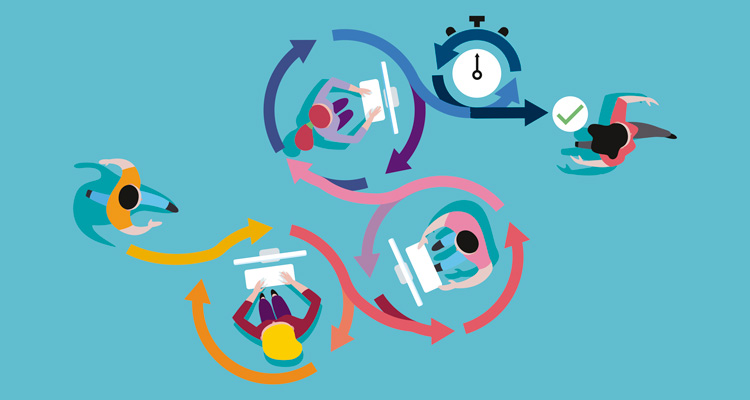
As a product leader, I get the question all the time: “Do you use your own products?” The answer is, “Of course we do.” It’s certainly true, but up until this point, usage was mainly in a department by department basis, with each department using the product slightly different and not necessarily connected. To provide credibility and understand our customers’ struggles better on their agile transformation journey to becoming Lean-Agile enterprises, we made a strategic decision to do the same. The decision to embrace Lean and Agile practices, principles, and ceremonies across our entire company AND use our own products in the process has proven to be a bumpy ride. Not because of our products of course, but because of the amount of cultural change our employees (like yours) go through before even getting to the product conversation. This Agile transformation journey has unraveled, in some cases, decades of working a certain way, and feelings run deep when you start breaking down organizational silos, reporting structures, sharing priorities—where people physically sit in an office—and measuring success.
To be clear, we are just starting our journey and certainly don’t have everything figured out, but we are learning new things every day about how to get better. We’re starting to see pockets of real success and outcomes, so I wanted to take a few minutes to share some of our learnings thus far to give you a glimpse inside how Planview is rewiring to support new ways of working.
1. We hired an Agile Coach.
The smartest thing we did was hire an EXTERNAL Agile transformation coach to help lead this initiative. We “interviewed” him by starting with a small value stream to see how this would pan out both personality-wise and strategically for our organization. Looking back, I firmly believe our transformation would never have worked if we had anointed someone internally to lead the charge. If we had, it would look like a “products thing”—or a “name your department thing”. Getting this neutral party that didn’t know any of our history or politics worked extremely well. The coach could come in and tell us what we needed to do and forced conversations that were years overdue—without any historical knowledge or bias.
2. Cultural change is hard!
I know people say this all the time, but by far the hardest part of this journey is the cultural change (and it’s ongoing). You are asking people to work differently, think differently, and act differently. And this is really hard. We emphasize to the company that this is about #rewire, as you just can’t talk about it enough—challenging long held beliefs to think in a new way. Embracing that you are now on a new dedicated team with a team lead but still have the same functional reporting structure. That in itself is a mind bender for some folks. The whole goal is to break down any silos in the organization, work on the most important things so we are working toward and measured by the same goals. Cultural change takes time, and yes, you might lose some people in the process because they can’t get on-board with the new world—that is okay. Change is messy and a lot of hard work, but completely worth it if everyone works on teams pulling in the same direction.
3. Dedicated teams are real.
The commitment to put people on dedicated teams instead of hoping part-time will suffice is critical to make an enterprise-wide Agile transformation work. People who are only dedicated to a team part-time are constantly pulled into other work they cannot say no to—this is all unplanned work and completely disrupts the ability of the full team to commit and deliver on scheduled work. And, let’s be honest. If you continue down this “part-time path,” you’re not doing anything different from traditional project-based demand management. It will never be a high-performing Agile team, and you’ll continue to ask, “why aren’t we getting to market faster like we were promised would happen with an Agile transformation?”.
Next to culture change, this is one the biggest reasons why Agile transformations fail: a lack of dedicated team structure.
A sure sign that a company is serious about the move to dedicated teams is when people actually move their desks and sit together in a cohesive unit—away from their functional teams. Obviously, this improves communication, collaboration, and team unity. Another true signal of Agile commitment is to give these dedicated teams budget that they control. Let the teams decide how to best spend the money allotted to them. If you have remote employees as part of the team, get creative—maybe have a constant FaceTime or Zoom session going so it’s very easy to include them. I fully believe that Agile will not work unless these teams form a bond and learn how best to work with each other. It’s through this bond and commitment that a team becomes high performing.
4. Agree upon the priority list and have the discipline to decide what gets de-prioritized if new work is given to the teams.
Honestly, this is still a big work in progress as a discipline for our teams. We are all so used to taking on more and more work and just figuring out a way to get it done. A lot of us come from start-ups, and there was just not room to say “no.” What has helped is not thinking about saying “no” but to say, “not now.” The hardest thing is to force a priority decision when we should be aligned to an agreed priority backlog from the Lean Portfolio Management (LPM) steering team. The cut line should not move down, but new epics and/or initiatives should be moved around in priority and then agreed as to what goes below the line “for now.” If the LPM steering team does not make sure these conversations are had and communicated to the entire value streams, we suffer from “peanut butter spreading” work across too many things—never doing anything in a world class way—and inevitably outcomes will reflect these decisions.
5. Get executives to participate early and often.
This seems like a really obvious point, but if you don’t have executives all-in on this transformation, it will be a constant uphill battle, and you’ll likely fail. Agile transformations driven only from the bottom-up will not work—period. You need key executive representation in PI Planning, even if it does not involve their teams initially. Executives need to believe to their core that this the way to go, because there will be very hard days, and it would be easy to just throw out the towel. One idea is to have the leadership team themselves go through PI Planning with their teams and change the way they operate as a team as well—setting a great example for the rest of the organization, but also getting to “feel the pain” so they can relate to the change that is asked of their individual teams.
6. Don’t shy away from hard discussions.
One of the unheralded side effects of scaling Agile is forcing hard, previously off-limits, topics. I will borrow some key Agile working agreement tenets—of course you need to respect everyone’s “humanness” in the room, but that does not mean you need to shy away from having tough conversations—no matter title or stature. It should be a safe place, and everyone needs to feel that they’re part of the process and heard. Confidence votes seem a little awkward but are a key part of making everyone feel heard. Hard conversations are never as hard as we imagined they would be—usually the hardest thing is just starting these discussions and feeling okay with bringing anything up. An entry level employee should feel empowered to ask or question of a c-level executive on anything. A good coach can help guide and facilitate these tricky conversations, but in my experience, I haven’t seen a downside to having candid dialogues, and more often than not, we end up solving the issue because we got the topic out on the table.
7. Small steps at one time.
A surefire way for an Agile transformation to stagnate is to try to boil the ocean all at one time. It is so important to do this in phases—you will be amazed how much better PI Planning gets each quarter that you do it. We learn so much each time, and teams typically hit their strides after 2 or 3 PI Planning exercises. One of the smartest things we did was listen to our coach’s advice and focus on one value stream and pass these learnings on before starting with new value stream teams.
8. Departments outside of dev and IT need more education and coaching.
This might again seem a bit obvious, but this is a real thing. Most development and IT organizations are very conversant around Agile, and most have implemented some version of Agile practices, principles, and/or ceremonies. The rest of the organization typically has NO idea what Agile means—there needs to be a lot of Agile 101 including terms and acronyms. I highly recommend not starting with these teams, as it takes more time to embrace and be on board, but rather, it’s better to be able to show progress and a strong foundation in areas more familiar with Agile. Marketing is a great place to consider early value streams to start with, mainly because of the cross-departmental nature of the work marketing typically needs to do to be successful.
9. Get teams to buy-in to one solution.
Sticky notes work great during PI Planning because they are easy to move around quickly to show the entire body of work needed. But after PI Planning, the teams need to track their progress visually and, even more importantly, have a way to roll all this Agile work up into a consolidated team of teams view. Kanban works very well for this approach, but with enterprises with multiple product lines working off multiple Kanban boards, it is imperative for senior leaders to have the needed visibility to help set priorities and see progress easily. Planview, of course, has solutions to help companies with the needed visibility to help drive enterprise-wide Agile transformations. Shameless plug complete.
10. Don’t underestimate how hard it is and be okay with that understanding.
This was the biggest lesson for our teams. An Agile transformation is not for the faint of heart; this is really hard stuff. We underestimated how hard this would actually be—mainly due to how hard it is to change an entire organization’s culture and employees’ mindsets. However, the journey to change is so worth it as soon as you see the benefits of working this way through shared goals and measurable outcomes. As teams hit their stride, it is awesome to see the cohesion and empowerment that teams now have, and I am so excited to see what we are going to accomplish when working in this new way.
Thankfully our executive team is all-in, and this has helped move things along. I am positive that there will be a part 2, so stay tuned. If you enjoyed this blog, I invite you to read the eBook, “Why Lean-Agile Culture Shifts Fail: Learn to Shift your Mindset, Not Just Practices and Processes”.






